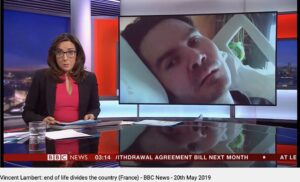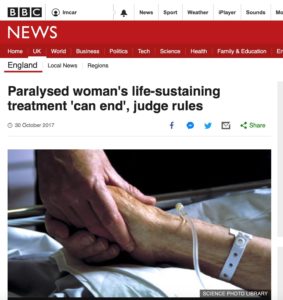
MODULE 4: Framing Law and Science
4.2 Court conflicts
The previous unit focused on the reporting of landmark cases which helped change the law in countries around the world to permit life-sustaining treatment, particularly the feeding tube, to be withdrawn in certain cases e.g . If further treatment were futile, the patient had a secure diagnosis and their doctors and family agreed that this was in their best interests and what they would have chosen for themselves if they could.
In most countries there was no need to go to court for each individual case after this. (The UK was, until 2018, an exception, but we won’t go into that here and UK law has now come into line with most other countries discussed here).
Once the principle that treatment could be stopped was established then the courts serve an important function in cases where there are disputes about the right way forward for an individual patient and it is these cases which have dominated legal coverage since.
In the Terri Schiavo case in the USA her parents and husband were in conflict over what should happen. This was a very public battle and involved interventions from leading political figures and intense media campaigns over many years – some of which has already been discussed in the units on ‘Politics of Visualisation’ and “Moving Images’. There is lots of opportunity for some coverage of court cases can be problematic and convey misleading information. For further discussion of the Terri Schiavo case look at the references listed in the ‘Resources’ unit (Module 5).
In France a similar case blew up around Vincent Lambert – triggering religious, political and social conflict – including major demonstrations. Again the conflict here was between his parents (who wanted treatment continued) and his wife who did not. The case attracted supporter/opponents on each side. The BBC declared that the end-of-life debate around Lambert: “divides a country”.


Our analysis of media reporting 2008-2017 highlights problems with the language used in reports, gaps in what was discussed and the promotion of some unjustified assumptions. Think about the issues you have noticed in media reports of court cases and then click on the cards below.
We hope this brief introduction to some general issues with legal reporting may have inspired you to want to look more closely at some legal cases in the news. In the activities below you can delve more deeply into one case: exploring how it was reported, gaiingn insights into the hearing itself, and directly accessing source material.
Activity 1, (Estimated time: 15 mins)

Have a look at the headline on the right – what do you think this patient’s diagnosis might be?
Then read the short news report about a court case here
Then answer the following questions:
- Do you think the headline was clear and accurate?
- Have a close look at the stock photograph used to illustrate this report – it isn’t a sleeping beauty image, but what aspects of it do you think are accurate for this patient (an elderly woman in a care home). For example are there a couple of things which imply a certain type of medical intervention or location?
- The report is about a dispute – make a note of who is in dispute with whom.
Keep you notes on this and proceed to Activity 2
Activity 2, (Estimated time: 20 mins) Delve into a court hearing and explore the evidence presented
We (at the ‘Coma and Disorders of Consciousness Research Centre’) have been keen to expand reporting of court cases. As well as working with journalists to inform reporting we have attending court hearings and live-tweeted the evidence and legal arguments as they unfolded in the court. We did this in the hope it would help public engagement with the debates.
 You can get a flavour of how evidence is presented in these cases by looking at the record of our tweets from the ‘Mrs P’ hearing here.
You can get a flavour of how evidence is presented in these cases by looking at the record of our tweets from the ‘Mrs P’ hearing here.- You can compare our tweets to the news report you looked at above – what do you learn from the tweets from the hearing that is different from what you learn from the news report of the judgment? One thing you might pay attention to is who is ‘in dispute’ – this is not just a dispute between one side of the patient’s family and another, who else is taking a position on what should happen to Mrs P?
- What else do you learn from the tweets from the hearing that is different from the news report of the judgment?
Activity 3 - optional, examine the written record of the court judgment
(Estimated time: 2 hrs)
 A useful resource is to get hold of a transcript of the judgment itself. This allows you to explore the reasoning of the judge and the evidence taken into account, and will give far more (and sometimes different) details than journalists’ accounts.
A useful resource is to get hold of a transcript of the judgment itself. This allows you to explore the reasoning of the judge and the evidence taken into account, and will give far more (and sometimes different) details than journalists’ accounts.
In the UK you can find such judgments in www.balii.org. For example, a copy of the actual judgment from the court case about ‘Mrs P’ can be found here: https://www.bailii.org/ew/cases/EWCOP/2017/23.html.
Read this judgment and:
a) systematically compare it to the tweets from the hearing
b) systematically compare it to news reports about this case, what elements have journalists picked out, and what elements do not gain media attention?
Write a commentary of your findings from this comparison.
9 Comments
Leave a reply
You must be logged in to post a comment.


I always find the court judgements entirely compelling to read, they often convey the compassion and understanding that the judges use when making these decisions, however I am pleased that families no longer have to go through this process when everyone is in agreement regarding the decision to be made.
It was very interesting reading the facts/ court case vs what did the news tried to tell… and the photo…….
This is the first time I have read an actual judgement from the court case, very interesting! and how very different from reading the news with the photo attached…..
I always read the judment from the courts around the world and I have a collected cases about this theme and it is so interesting see how the arguments are similars in them.
That’s a very thorough Twitter thread on Wakelet demonstrating good advanced preparation of materials to link to! Not heard of “hot-tubbing” in a legal sense previously.
Thanks Chris.
I think working backwards from press reporting, to actual judgment and back to an account of the hearing is always really enlightening. I like the way a live-tweeting of a hearing can capture a flavour of the questioning and arguments as they unfold – almost like a little ‘play’ (https://wakelet.com/wake/1ee8ce21-250b-42ac-b0b7-5195640abc4b.
Anyone who wants to attend a hearing themselves in the Court of Protection might want to look at this website; https://openjusticecourtofprotection.org
I was thinking about the “best interest” standard. According to the Convention on the Rights of Persons with a Disabilities you are suppose to use the “will and preferences” standard. I know that is not possible all the times, but I think it should be the first criteria to use in this cases. However, it’s importante to notice that this process of determining the will and preferences could be very exhausting for family. Lambert case has been argued in local courts, in the European Court of Human Rights, and it’s currently pending on the Commitee in the Rights of Persons with Disabilities.
Yes, I definitely agree with you about how the United Nations CRPD applies here, and also indeed, how exhausting this is for family. These cases also show how very destructive too it can be if different members of the patient’s family have different views. That’s one reasons why I think itis such a good idea for all of us to put something in writing about what we think we would want – even if it is just having a conversation and then trying to put one’s thoughts into an email so no one has to argue whether or not you really said it
I’ve written an email about my wishes, I’ve also recorded a film of myself talking about my values, wishes, beliefs and feelings in general (and sent a copy to family/friends for storage/discussion), and I have assigned LPA welfare to the person I trust most to represent me, and I have an Advance Decisions…Belt and braces, and .little room for those who care about me to argue!!
For England/Wales for help with the formal appointment/documentation see: http://mydecisions.org.uk
Even more important than having advance directives, and those are vital, is having the conversation with your family and friends about your end-of-life wishes. Picking the right proxy is also key. You need someone who will fight for your wishes and not be intimidated by doctors or even other family members. There are now even forms in case of dementia but those really need to also have a video to spell out your wises, especially about nutrition and hydration. The movie Still Alice is a great picture and a cautionary tale about dementia.
The Conversation Project: https://theconversationproject.org/starter-kits/